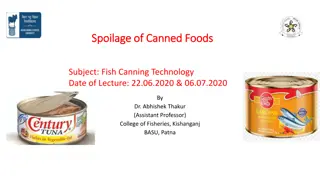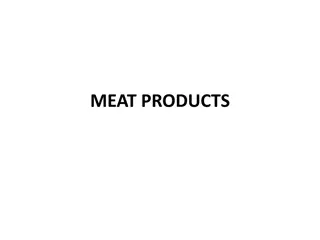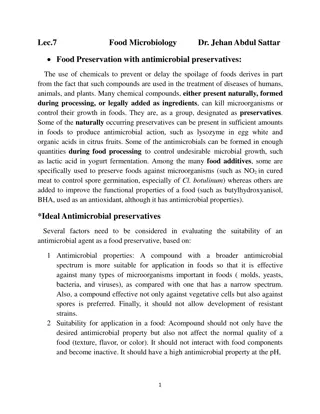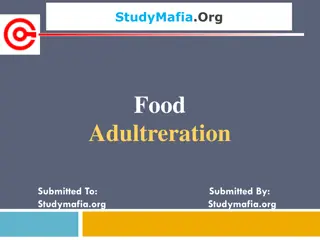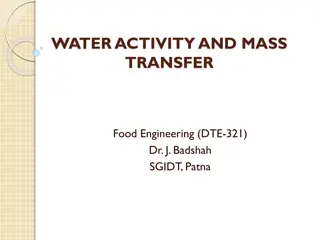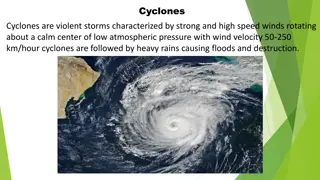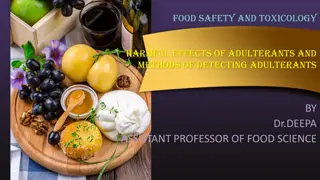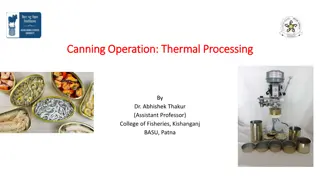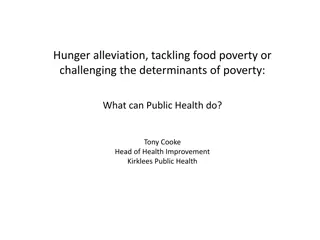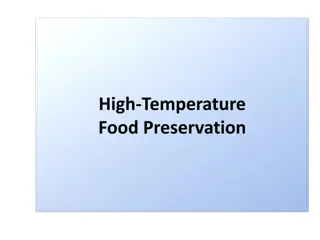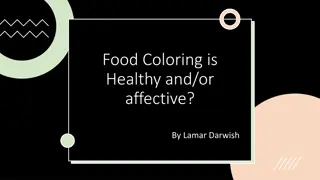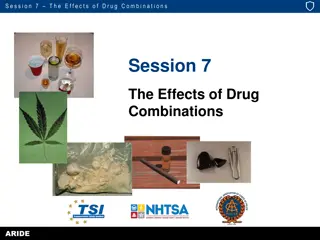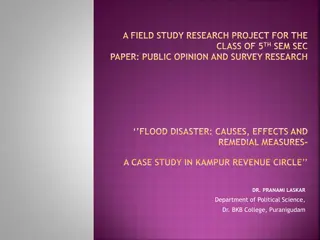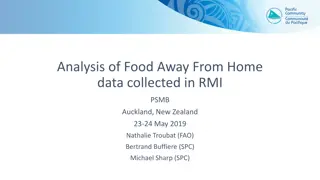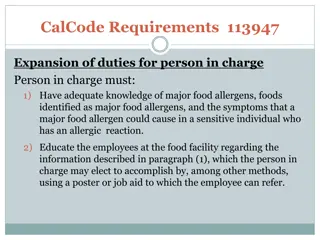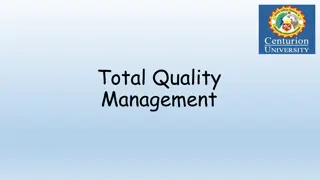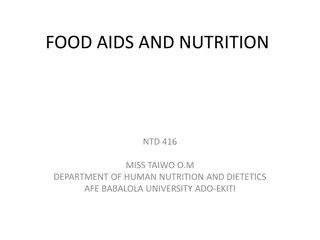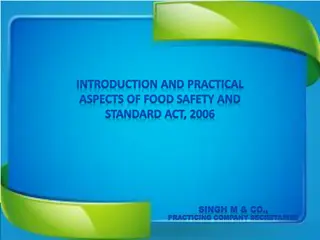Understanding Food Spoilage: Causes and Effects
Food spoilage is the deterioration of food to the point where it is no longer safe or suitable for consumption. It can occur due to various factors such as insect damage, physical injury, enzymatic degradation, microbial growth, temperature fluctuations, and more. Different types of spoilage can be identified through changes in appearance, texture, taste, and odor. Proteins may putrefy, fats can turn rancid, carbohydrates may become slimy, and fruits and vegetables can rot and decay. Understanding these processes is crucial for maintaining food safety and quality.
Download Presentation

Please find below an Image/Link to download the presentation.
The content on the website is provided AS IS for your information and personal use only. It may not be sold, licensed, or shared on other websites without obtaining consent from the author. Download presentation by click this link. If you encounter any issues during the download, it is possible that the publisher has removed the file from their server.
E N D
Presentation Transcript
Spoilage is the process in which food deteriorates to the point in which it is not edible to humans or its quality of edibility becomes reduced. It involves any change which renders food unacceptable for human consumption. Spoilage of food can occur through: 1. Insect damage 2. Physical injury due to freezing or moisture loss 3. Activity of indigenous enzymes in plant and animal tissues 4. Chemical changes involving oxygen (oxidation) and light e.g. oxidative rancidity of fats and oils, the discoloration of cured meats, 5. Growth and activity of microorganisms: bacteria, yeasts and moulds. 6. Temperature fluctuation
Food spoilage Basic Types of Food Spoilage Appearance: Spoilage of foods due to microbial growth may include mycelia or colonies visible on surface and development of cloudiness in liquids Changes in food color due to heme or chlorophyll breakdown Slime formation due primarily to surface accumulation of microbial cells Tissue softening due to enzymatic degradation Changes in taste and odor due to development of nitrogenous compounds (ammonia, amines, etc.), sulfides, organic acids
Protein food They go putrified when they are contaminated. This is the situation where protein foods rot, and produce very bad smell. Fats and oils They go rancid. This is the condition where food containing fats and oils begin to smell and taste bad when they are old. Carbohydrates Cooked cereals become marshy and slimy when affected by micro- organisms. Flour products smell and taste unpleasant when they are spoilt. They are described as being stale. Fruits and vegetables rot, ferment and decay.
Physical injury 1. Moisture loss Moisture loss mostly occurs in fruit and vegetables which contain large amounts of water. Fruits and vegetables continue to respire after harvesting and therefore lose water through their leaves and skin. The water retains the structures of the cells of the plants and makes them look fresh. Moisture loss causes the vegetable or fruit to shrink in size, becomes limp and its skin becomes wrinkled and leathery. Moisture loss occurs in other foods like meat, fish, cheese, due to evaporation of water from the surface.
Activity of indigenous enzymes Enzymes are present in all food. They speed up chemical changes that result in loss of flavour, colour and texture. Some enzymes remain inactive until the food is harvested or slaughtered. Once activated, such enzymes speed up the process of decay by breaking down the tissues and components of the food in the various ways such as oxidation, browning and ripening. Enzymes are mainly composed of protein, they are sensitive to heat. The activity of these enzymes stops when they are heated above 70 oC. The activity of enzymes in food makes it easier for the micro-organisms responsible for food spoilage to enter the food. Heat treatment by blanching (i.e. pouring boiling water on the food) is recommended to deactivate enzymes in foods.
Chemical changes Oxidation-When Oxidation occurs (i.e. when food comes into contact with oxygen) the enzymes cause the destruction of certain nutrients e.g. vitamin C, thiamin and carotene. Browning -Enzymes again cause browning in certain foods the moment they are exposed to air. When you cut or bruise food such as apple or yam, the exposed surface will discolour and turn brownish due to the activity of enzymes. Ripening-Enzymes are involved in the process that causes ripening in certain foods such as fruits and vegetables. Unripe bananas for example contain starch which is gradually converted to sugars, until the banana becomes very sweet, and its skin colour changes from green to yellow. Eventually, the skin colour changes to dark brown and it is no longer fit to be consumed.
Growth of microorganisms The main micro-organisms responsible for the contamination of food are bacteria, moulds and yeasts. They are capable of multiplying very rapidly in the correct moisture, food and temperature conditions Moulds -They settle and multiply on suitable foods. At this stage, they are visible as a fluffy coloured mass and the food is said to have gone mouldy. Food that is contaminated with mold often appears to be safe to eat as only the outer part is affected by mold growth. However, recent research has shown that substances produced by the mold, mycotoxins, which migrate into the food could be harmful to many organs of the body.
Yeasts -Yeasts are microscopic fungi; they are found in the air and soil, and on the surface of fruit. Some are able to tolerate fairly high acidic, salt and sugar concentrations and can grow without the presence of oxygen. They can cause food spoilage in syrups, fruits, fruits juices and jam especially as they can survive without air. Bacteria -Bacteria are the most widespread of the micro-organisms found in food. They are minute single cells of various shapes. Under ideal conditions, they divide into two every 20 minutes, consequently, millions of them may develop in contaminated food in a short time. They are active over a wide range of temperatures The removal of moisture by drying or by addition of large quantities of sugar and salt make conditions unsuitable for bacteria, and these methods are therefore use in food preservation.
Temperature fluctuations May cause growth of different microbes in the food May cause breakdown of heat sensitive components of the food
Effects of food spoilage Deterioration leads to wastage of food Prevention of wastage enhances availability of food through all seasons of the year Contaminated food can cause illness and food poisoning in severe cases Money is saved when food commodities are kept from spoilage Degradation of the nutritive value of food
Prevention of food spoilage Spoilage in foods can be prevented, delayed, or reduced A food rotation system uses the first in first out method (FIFO), which ensures that the first item purchased is the first item consumed. Preservatives can expand the shelf life of food and can lengthen the time long enough for it to be harvested, processed, sold, and kept in the consumer's home for a reasonable length of time. Salting (We can add salt to preserve pickles and fish) Sweetening-Excess sugar in food also acts as a preservative. The most notable is simple osmosis, or dehydration. Salt or sugar, whether in solid or aqueous form, attempts to reach equilibrium with the salt or sugar content of the food product with which it is in contact. This has the effect of drawing available water from within the food to the outside and inserting salt or sugar molecules into the food interior. The result is a reduction of the so-called product water activity (aw), a measure of unbound, free water molecules in the food that is necessary for microbial survival and growth. Salt and sugar's other antimicrobial mechanisms include interference with a microbe's enzyme activity and weakening the molecular structure of its DNA. Sugar may also provide an indirect form of preservation by serving to accelerate accumulation of antimicrobial compounds from the growth of certain other organisms. Examples include the conversion of sugar to ethanol in wine by fermentative yeasts or the conversion of sugar to organic acids in sauerkraut by lactic acid bacteria.
Refrigeration can increase the shelf life of certain foods and beverages, though with most items, it does not indefinitely expand it. Freezing can preserve food even longer, though even freezing has limitations. Canning of food can preserve food for a particularly long period of time, whether canned at home or commercially. Canned food is vacuum packed in order to keep oxygen out of the can that is needed to allow bacteria to break it down. In this method, air is removed from food and put in airtight cans so that germs do not grow on them. Food items like vegetables, seafood, dairy products etc. are preserved through this method. Lactic acid fermentation also preserves food and prevents spoilage. Controlling heat, moisture and pH helps to inhibit spoilage by preventing microbial growth and slowing down the food's natural breakdown process. Cooking food deactivates enzymes and kills bacteria and fungi, but this process is only permanent for enzymes. Dehydration-In this method, the food items are dried in sun to stop the growth of bacteria in them. Certain foods, like raw mangoes, fishes, potato chips are preserved by this method.
Food Poisoning Food poisoning, also called foodborne illness, is illness caused by eating contaminated food. Infectious organisms including bacteria, viruses and parasites or their toxins are the most common causes of food poisoning. Infectious organisms or their toxins can contaminate food at any point of processing or production. Contamination can also occur at home if food is incorrectly handled or cooked. Food poisoning symptoms, which can start within hours of eating contaminated food, often include nausea, vomiting or diarrhea. Most often, food poisoning is mild and resolves without treatment. But some people need to go to the hospital.
Symptoms Food poisoning symptoms vary with the source of contamination. Most types of food poisoning cause one or more of the following signs and symptoms: Nausea Vomiting Watery or bloody diarrhea Abdominal pain and cramps Fever Signs and symptoms may start within hours after eating the contaminated food, or they may begin days or even weeks later. Sickness caused by food poisoning generally lasts from a few hours to several days.
Causes Contamination of food can happen at any point of production: growing, harvesting, processing, storing, shipping or preparing. Cross-contamination the transfer of harmful organisms from one surface to another is often the cause. This is especially troublesome for raw, ready-to-eat foods, such as salads or other produce. Because these foods aren't cooked, harmful organisms aren't destroyed before eating and can cause food poisoning. Many bacterial, viral or parasitic agents cause food poisoning.
Contaminant Onset of symptoms Foods affected and means of transmission Meat and poultry. Contamination occurs during processing if animal feces contact meat surfaces. Other sources include unpasteurized milk and contaminated water. Campylobacter 2 to 5 days Home-canned foods with low acidity, improperly canned commercial foods, smoked or salted fish, potatoes baked in aluminum foil, and other foods kept at warm temperatures for too long. Clostridium botulinum 12 to 72 hours Meats, stews and gravies. Commonly spread when serving dishes don't keep food hot enough or food is chilled too slowly. Clostridium perfringens 8 to 16 hours Beef contaminated with feces during slaughter. Spread mainly by undercooked ground beef. Other sources include unpasteurized milk and apple cider, alfalfa sprouts, and contaminated water. Escherichia coli (E. coli) O157:H7 1 to 8 days
Raw, ready-to-eat produce and shellfish from contaminated water. Can be spread by an infected food handler. Hepatitis A 28 days Hot dogs, luncheon meats, unpasteurized milk and cheeses, and unwashed raw produce. Can be spread through contaminated soil and water. Listeria 9 to 48 hours Raw, ready-to-eat produce and shellfish from contaminated water. Can be spread by an infected food handler. Noroviruses (Norwalk-like viruses) 12 to 48 hours Raw, ready-to-eat produce. Can be spread by an infected food handler. Rotavirus 1 to 3 days Raw or contaminated meat, poultry, milk, or egg yolks. Survives inadequate cooking. Can be spread by knives, cutting surfaces or an infected food handler. Salmonella 1 to 3 days Seafood and raw, ready-to-eat produce. Can be spread by an infected food handler. Shigella 24 to 48 hours Meats and prepared salads, cream sauces, and cream- filled pastries. Can be spread by hand contact, coughing and sneezing. Staphylococcus aureus 1 to 6 hours Raw oysters and raw or undercooked mussels, clams, and whole scallops. Can be spread through contaminated seawater. Vibrio vulnificus 1 to 7 days
Risk factors Whether you become ill after eating contaminated food depends on the organism, the amount of exposure, your age and your health. High-risk groups include: Older adults. As you get older, your immune system may not respond as quickly and as effectively to infectious organisms as when you were younger. Pregnant women. During pregnancy, changes in metabolism and circulation may increase the risk of food poisoning. Your reaction may be more severe during pregnancy. Rarely, your baby may get sick, too. Infants and young children. Their immune systems haven't fully developed. People with chronic disease. Having a chronic condition such as diabetes, liver disease or AIDS or receiving chemotherapy or radiation therapy for cancer reduces your immune response.
Complications The most common serious complication of food poisoning is dehydration a severe loss of water and essential salts and minerals. Infants, older adults and people with suppressed immune systems or chronic illnesses may become severely dehydrated when they lose more fluids than they can replace. In that case, they may need to be hospitalized and receive intravenous fluids. In extreme cases, dehydration can be fatal.
Some types of food poisoning have potentially serious complications for certain people. These include: Listeria monocytogenes. Complications of a listeria food poisoning may be most severe for an unborn baby. Early in pregnancy, a listeria infection may lead to miscarriage. Later in pregnancy, a listeria infection may lead to stillbirth, premature birth or a potentially fatal infection in the baby after birth even if the mother was only mildly ill. Infants who survive a listeria infection may experience long-term neurological damage and delayed development. Escherichia coli (E. coli). Certain E. coli strains can cause a serious complication called hemolytic uremic syndrome. This syndrome damages the lining of the tiny blood vessels in the kidneys, sometimes leading to kidney failure. Older adults, children younger than 5 and people with weakened immune systems have a higher risk of developing this complication.
Prevention To prevent food poisoning at home: Wash your hands, utensils and food surfaces often. Wash your hands well with warm, soapy water before and after handling or preparing food. Use hot, soapy water to wash utensils, cutting boards and other surfaces you use. Keep raw foods separate from ready-to-eat foods. When shopping, preparing food or storing food, keep raw meat, poultry, fish and shellfish away from other foods. This prevents cross-contamination. Cook foods to a safe temperature. The best way to tell if foods are cooked to a safe temperature is to use a food thermometer. You can kill harmful organisms in most foods by cooking them to the right temperature. Cook ground beef to 160 F (71.1 C); steaks, roasts and chops, such as lamb, pork and veal, to at least 145 F (62.8 C). Cook chicken and turkey to 165 F (73.9 C). Make sure fish and shellfish are cooked thoroughly.
Refrigerate or freeze perishable foods promptly within two hours of purchasing or preparing them. If the room temperature is above 90 F (32.2 C), refrigerate perishable foods within one hour. Defrost food safely. Don't thaw food at room temperature. The safest way to thaw food is to defrost it in the refrigerator. If you microwave frozen food using the "defrost" or "50 percent power" setting, be sure to cook it immediately. Throw it out when in doubt. If you aren't sure if a food has been prepared, served or stored safely, discard it. Food left at room temperature too long may contain bacteria or toxins that can't be destroyed by cooking. Don't taste food that you're unsure about just throw it out. Even if it looks and smells fine, it may not be safe to eat.
Food poisoning is especially serious and potentially life-threatening for young children, pregnant women and their fetuses, older adults, and people with weakened immune systems. These individuals should take extra precautions by avoiding the following foods: Raw or rare meat and poultry Raw or undercooked fish or shellfish, including oysters, clams, mussels and scallops Raw or undercooked eggs or foods that may contain them, such as cookie dough and homemade ice cream Raw sprouts, such as alfalfa, bean, clover and radish sprouts Unpasteurized juices and ciders Unpasteurized milk and milk products



